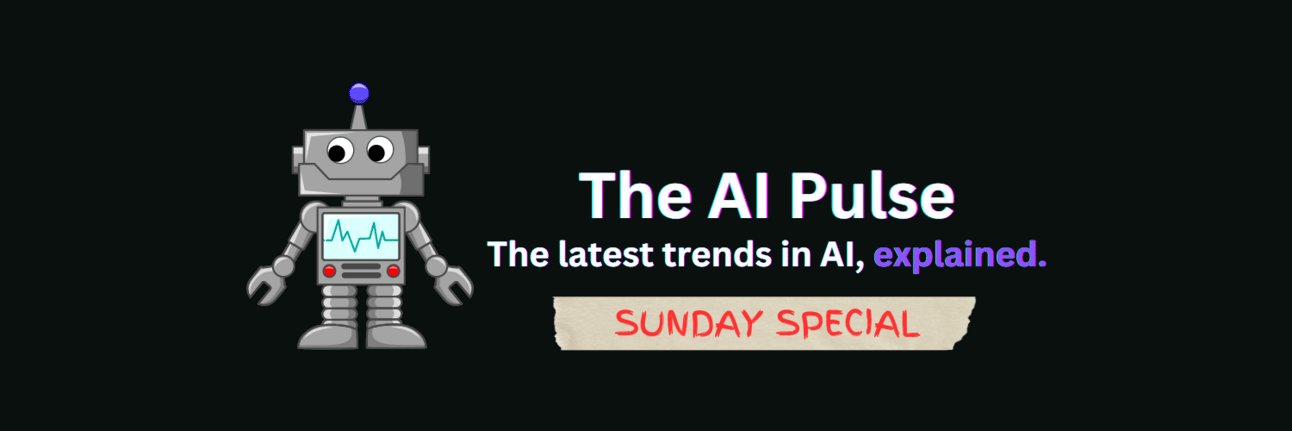
Welcome back AI prodigies!
In today’s Sunday Special:
📜The Origin of Deepfakes
🚨Most Can Spot Them. Can You?
🕵️♂️AI, The Deepfake Detector
Read Time: 6 minutes
🎓Key Terms
Deepfake: the hyperrealistic manipulation of media through computer-created artificial videos that depict events, statements, or actions that never happened.
Section 230: a widely cited section of the Communications Decency Act that provides legal immunity for online computer services, including social media companies, concerning third-party content generated by users.
Computer Vision: developing algorithms to enable machines to identify and analyze objects, shapes, colors, and even motion in images and videos.
Supervised Algorithm: a machine learning algorithm that collects data or generates outputs from previous experiences to anticipate future events.
Photoplethysmography: an optical technique used to detect volumetric changes in blood circulation.
📜THE ORIGIN OF DEEPFAKES
Like many of the hottest things in AI (e.g., chatbots, recommendation algorithms, etc.), deepfakes have been around for quite some time. The first notable deepfake attempt came in a 1997 research project called the Video Rewrite Program. Researchers synced an existing video of a person speaking to a different audio track by altering their mannerisms and mouth gestures. In the famous video, a female character robotically declares, “My face is Ellen’s, my voice is Michelle’s. Ellen did not say these words. Michelle did.” Though impressive, its scattered eye movements, awkward head shakes, and monotony expose its veracity. But the world has transformed in 26 years. In 1997, 70 million people used the internet. Today, 5.3 billion do. Just like the internet today, our deepfake landscape is indistinguishable from 1997. And deepfakes have already become just that—indistinguishable from reality.
🚨MOST CAN SPOT THEM. CAN YOU?
Static Images: In one widely cited study, researchers built a digital platform containing authentic and manipulated pictures. Over 15,000 respondents guessed “fake or real” based on the image presented. Across several rounds, they received feedback about their accuracy. The results reveal that people’s accuracy increases over time, stabilizing at a rate of 88%.
Deepfake Videos: Research on people detecting deepfake videos is sparse. In an online study, 882 individuals watched 56 pairs of videos (i.e., one real and one fake), and 82% of participants outperformed the leading machine model, which was 65% accurate in 2020. Unlike the static images study, they found no evidence that participants improved their ability to detect videos after the first ten videos were seen.
You can also participate in a deepfake detection study. MIT Media Lab recently launched Detect Fakes, a research initiative that tests our ability to detect synthetic media. They combined 20 silent videos, audio excerpts, and text outputs of politicians into a 10-minute quiz. I got 13 out of 20 correct, no better than the bot😬. Think you can do better? Take the quiz. Then, scroll to the bottom and rate this newsletter to tell us your score. We’ll report the results next Sunday and shout out the highest scorer!
In my experience, judging the silent video and text-based excerpts was the most difficult. Also, I performed better when I trusted my gut; overthinking backfired four times. While a 65% success rate is significantly better than guessing, the vigilance accompanying a deepfake detection test enhances performance. During TikTok and Instagram scrolls or YouTube binges, our executive function diminishes.
🕵️♂️AI, THE DEEPFAKE DETECTOR
Fortunately, content publishers are taking steps to flag, label, and remove political deepfakes before they surface on users’ feeds. Meta banned political advertisers from using generative AI tools in Facebook and Instagram ads. Microsoft deployed Content Credentials as a Service, a watermarking tool that empowers election campaigns to verify the origins and truthfulness of political content. Though platforms currently cannot be held liable for publishing deepfakes, a bipartisan group of senators introduced the Protect Elections from Deceptive AI Act to end Section 230 immunity protections for materially deceptive, AI-generated images or videos of federal political candidates. As we explained last week, there is no legislative consensus on what a “deepfake” is; it will likely emerge in the coming months after computer scientists and policymakers develop comprehensive AI regulation.
Regardless of regulation, no technology giant can label and remove problematic content at scale. Nevertheless, emerging technologies like computer vision and deep learning will be essential in moderating the AI-generated content they create. One unique detection tool is Intel’s FakeCatcher, which boasts a 96% accuracy rate. This real-time detection software analyzes the blood flow of individuals in potentially doctored media. When the heart pumps blood, veins change color. Photoplethysmography techniques collect data on light by analyzing photo or video pixels, which are either absorbed or reflected by the blood vessels living in tissues. Then, researchers use this data to train a supervised machine-learning algorithm to predict the probability of media manipulation. Though FakeCatcher has made significant progress, many questions remain about its feasibility and scope: the subject must be entirely visible, so odd video angles or audio clips won’t work; lighting and skin color may inhibit its sky-high accuracy; the public must trust its judgments.
Another detection tool, DeepFake-o-meter, is free and open to the public. We warn you—it's a bit cumbersome, as users must select from a menu of deepfake detection methods. Other tools, such as Deepware, are more user-friendly, but their accuracy is unclear. As always, deepfake-detecting AI tools can’t trump the evolutionary cocktail of common sense, critical thinking, and human intuition. At least not yet.
📒FINAL NOTE
If you found this useful, follow us on Twitter or provide honest feedback below. It helps us improve our content.
How was today’s newsletter?
❤️AI Pulse Review of The Week
“I come in peace…👽”
🎁NOTION TEMPLATES
🚨Subscribe to our newsletter for free and receive these powerful Notion templates:
⚙️150 ChatGPT prompts for Copywriting
⚙️325 ChatGPT prompts for Email Marketing
📆Simple Project Management Board
⏱Time Tracker
